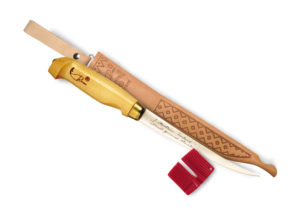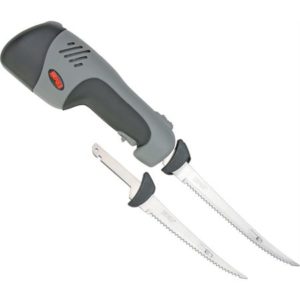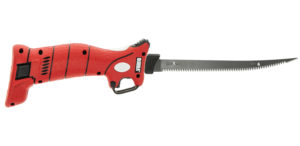A fillet knife is a critical piece of gear for the fishing enthusiast who keeps their catch. In many ways, the fillet knife is the only thing standing between your successful fishing and the consumption of a good, fresh fish dinner.
Fillet knives can be anything from wholly utilitarian to crafty works of art. Some are meant for cleaning as many fish as possible in the shortest amount of time while others are meant to be admired for a second each time you pick it up, ready to create fresh-caught fish fillets.
Either way, we wanted to summarize some of our favorite fillet knives on the market today, and check the box for all of the key categories that you might be considering.
Best Fillet Knives
Helle Fiskekniv
Best Fillet Knife for People Who Appreciate Handcrafted Goods
Helle, the Norwegian knifemaker, makes some of the best knives we have ever held in our hand. The Fiskekniv (Fisk is Norwegian for Fish and Kniv is Norwegian for Knife) is a beauty, with a  sanded wood handle and a polished stainless steel blade. For people who appreciate craftsmanship and like to have nice things, this is a great knife. It is also an excellent gift, because not only is it a fully-functional fillet knife but it is also a work of art.
sanded wood handle and a polished stainless steel blade. For people who appreciate craftsmanship and like to have nice things, this is a great knife. It is also an excellent gift, because not only is it a fully-functional fillet knife but it is also a work of art.
The Fiskekniv balances beautifully in your hand, and the roughly 6-inch blade length is perfect for fish of all sizes. We have cleaned smaller perch and crappies with the knife and it performed well. On the flip side, we have de-skinned our share of salmon and it performs just as well on a large cut. The knife is a very thin, slim feel, allowing the user to really sense that they have surgical control over the cuts they are making. The blade itself has the perfect stiffness, not succumbing to the issue we see with so many knifes, where the manufacturer tries to give the blade too much flex.
Helle has been around since the 1930s, and the company grew up on the beautiful Western coast of Norway. Anyone who has been to that area knows that fish are as integral to the region as wine is to Napa. They know a thing or two about what you need when you clean a fish, so these fillet knives earn our top spot.
Find the Helle Fiskekniv here on Amazon.
Bubba 9” Fillet Knife
Best Knife for Larger Fish
Bubba Blades makes a whole lineup of fillet knives of various sizes. We have been fans of their signature red knives ever since we used one a few years ago. 
We are recommending their large knife — the 9 incher — as a top pick. This is a great size for folks who usually clean larger catches like salmon, grouper, or halibut (if you are so lucky), but it also works great on northerns, larger walleye, and other freshwater fish. Additionally, we know that some fishermen are just used to using a long blade even on smaller fish and, if that is the feel you are most comfortable with, you will enjoy the 9” blade on the Bubba.
For reference, they also make a 6” blade that is popular as well, and features the same handle as the 9” knife.
Speaking of that handle, it is one of the things we really like about the Bubba brand. While there is no substitute for the silky-smooth feel of cradling a handcrafted, sanded wooded handle in the palm of your hand, sometimes having a little more of a grip is nice. The Buddy makes a textured, non-slip grip that is great inside a cleaning house, or on the side of a stream, when you might be both the “rinser” and the “filleter”, often working with wet hands.
Overall, this is a knife that does not disappoint. It might not be one you hang on your wall, but it works and holds its edge for a long time. You can clean a lot of fish with the Buddy knives.
Find the Bubba 9″ Fillet Knife here on Amazon.
Rapala Fish n Fillet
Best All-Purpose, Budget Knife
When it comes to a go-to, default knife, and one that does not break the bank, the Rapala Fish n Fillet might fit the bill. Made with a birch handle and a nice, tapered blade, the knife really performs in every situation. While it might not be as beautiful or as exquisitely balanced as the Helle, it is also a fraction of the price.
A nice thing about the Fish n Fillet is that it comes in three sizes. You can choose from a blade length of 4”, 6”, or 7 ½”. We would suggest you shy away from the 4” blade unless you are mainly cleaning panfish, in which case it could work pretty well. For most anglers who need to clean fish that could have some size, you will want to use the 6” or 7 ½” blades. 6” is a good all-purpose blade length in most parts of the country. If your typical catch is salmon or other large saltwater fish, you might be in the market for the 7 ½ incher.
Because of the affordable price point, this is the type of knife you can easily buy a few of. We know of fisherman who might have one in their tackle box, another in their vehicle, and perhaps keep one with their ice fishing gear. Maybe you need a less-expensive knife to keep in your pack for that occasional fly fishing shore lunch. If you want to splurge and go with a Helle for your lake cabin, you are pretty well covered no matter where you are. You can’t have too many fillet knives!
Of the cheaper fillet knives, this is the only one we recommend.
Find the Rapala Fish-N-Fillet here on Amazon.
Rapala Lithium Ion Electric Knife
Best Budget Cordless Fillet Knife
Whether you just want to fish to catch a limit each day or prefer electric, we’ll also suggest a few electric knives. We are going to start with the Rapala Heavy Duty. Rapala is a trusted name in fishing, making some of the finest lures around, and, of course, our favorite budget, all-purpose fillet knife which we wrote about earlier. 
A cordless knife is great in concept, but always begs the big question of: Will this thing actually cut without running out of battery life? While earlier versions of cordless electric fillet knives were not passing that test with flying colors, we can say that this version of the Rapala Li-Ion stacks up very well. The company advertises 80 minutes of battery life, and, based on our tests, we have no reason to doubt them.
We like that the Rapala comes with two blades, so you can swap them out based on the fish you are cleaning — or simply based on the length of knife you prefer. 6” and 7.5” blades give you plenty of choices for your cleaning. The only length you really lack is something short, and if you are cleaning panfish, you may prefer a hand-held knife anyway.
The total weight is almost 4 lbs, which may not seem like much but if you are holding that for several minutes at a weird angle, you may need to take a break. It’s also worth mentioning that this knife can get a little hot after a while, so you might want to stop for a bit anyway.
If you are tired of spending all of your wrist and elbow energy filleting fish manually, this can be a nice electric knife to have on hand.
Find the Rapala Li Ion Electric Fillet Knife here on Amazon.
Bubba Cordless Electric Fillet Knife
Best Overall Electric Fillet Knife
We profile the Bubba 9” hand fillet knife above, and we want to include their electric knife as one of the best options out there as well. If you need an assembly line in the fish cleaning house, after a great day of chasing walleyes, this knife might save you a lot of work.
great day of chasing walleyes, this knife might save you a lot of work.
In case you don’t know about the Bubba company, let us share a bit about what makes them special. Bubba Blades is a relatively new company, at least by knife-making standards. Unlike Helle or Rapala which have been around since before World War II, Bubba is relatively new on the scene in the past 10 years. And unlike Helle or Rapala which were founded in Scandinavia, Bubba was founded in sunny San Diego. You might think San Diego is only about surfboards and good West Coast IPAs, but Bubba figured out a way to make really good fillet knives.
Bubba’s Li-Ion cordless fillet knife has the same familiar feel as their excellent handheld fillet knife, with a nonslip grip in the signature red handle. It comes with four long blades: a 7-incher, two 9-inchers (a flexible one and a stiffer one) and 12 incher. That means that the Rapala might be more suited to smaller, inland catches, but if you are fishing anywhere near a coast or on the Great Lakes, these stiff, longer blades might be perfect for you. What we love about all of these blades, though, is that Bubba doesn’t make them any heavier than they need to be. They are slim enough to give you a pretty precise feel for an electric knife.
Additionally, we really like that the Bubba comes with two batteries, meaning that as long as you remember to charge one the night before your outing, you should never be without a fully-loaded battery. The batteries are beasts — we have yet to figure out at what point they die!
And best of all, it is light. Take away all the stuff it ships with, and this knife only weighs about a pound. That is pretty impressive for the package it gives you.
Find the Bubba Li Ion Electric Knife here on Amazon.
What To Look For in a Fillet Knife
Buying a fillet knife seems like it should be simple — you just look at the knife, look at the price, and get the one that seems like the best deal. Right? Wrong.
The temporary satisfaction you might feel about finding a bargain in the store will come back to bite you when you are struggling to clean your catch after a great day of fishing. Here are a few things to look for in the fillet knife that you select.
Quality
This should go without saying, not just for your knife, but for everything in your tackle box. If you buy quality, you will actually save money over the long run because you will not need to replace or upgrade as often. Pay particular attention to the joint where the blade meets the handle. If you start with a loose or imperfect fitting, it is sure to fail at some point along the way.
Blade Length
The blade length can range from about 4 inches at the low end to more than 10 inches at the high end. The length you should go with comes down to two things: what you are used to using, and what kind of catch you expect to be filleting. Generally speaking, larger fish call for larger knives. Panfish call for smaller knives. With that said, many fishermen prefer to use a blade a little longer than many would predict, because having a blade long enough to more-than-cover the vertical height of the fillet usually makes for a cleaner, more singular cut.
Blade Quality
Blade quality goes along with our quality point, but there are a couple specific things to look for in the blade. Typically, you want the thinnest blade possible to give you max control and touch, but you also want the blade to be both strong and flexible at the same time. Sound like a lot to ask for? That is why good fillet knives aren’t cheap — getting that combination of strength, flexibility, and thinness is hard to do and requires good materials!
As for materials, most good fillet knives are made of a polished stainless steel material or a teflon-coated stainless steel. Be wary of any knife that is trying to cut costs by reducing blade quality.
Handle and Grip
Handle and grip largely come down to personal preference, so it is important to get a feel for the knife — or if you are buying online, read the reviews. A good handle will rest comfortably in your hand and not make it tired after cleaning a single fish. Imagine if you are trying to clean a mess of perch and need to fillet for 45 minutes — will the handle still feel good? It is also important to have a grip that is capable of holding firm even when the knife might get a little wet or covered with a film of slime.
Balance is also important — when holding the knife, the whole unit should balance nicely in your hand. Everything we recommended above is a cut above in that regard. If it doesn’t have a good, natural feel, it didn’t make our list.
Portability
A good fillet knife should have portability for safety if you’re bringing it with you. Many knives are very effective when cutting, but hard to carry safely. Much like the advice we give to campers on carrying a camping saw, be sure you can cover the blade with certainty if the knife will be in your gear. The last thing you want is a knife blade going rogue and damaging the other stuff you brought along.
Electric versus Old-Fashioned
Whether you go with an electric knife or an old-fashioned manual knife is largely a matter of personal preference. As you might expect, an electric knife can really plow through lots of fillets in a short amount of time. If you are someone who tends to keep everything you catch, who gets the occasional mess of crappies that can be cumbersome to clean, an electric knife might be worth looking at. The downside is that you lose some of the “touch” or feel with an electric knife, if you are cleaning a delicate cut or are extremely particular with the details of your cut. They are also a little heavier — you probably wouldn’t carry one around in your backpack.
A regular, old-fashioned knife, on the other hand, can be a work of art. Many old-timers we know prefer to use a manual knife, even though they are fully aware that an electric knife could save time. They just prefer the feel and control they have using a regular knife. For those who might be carrying a fillet knife with them on a backpacking or canoe trip, an old fashioned option is lighter, earlier to pack, can be submerged without being damaged, and the ones we recommend above all come with a leather sheath which can either attach to a belt or just be used as a knife housing for protection inside other bags.
What Are You Used To?
I have seen it dozens of times. I fish with someone, we have a great day and keep a few, and decide to clean them. I hand them a fillet knife, and it just feels weird to them. Maybe it is too stiff. Maybe the blade is too short. I know I handed them a good knife, the only problem is that they are used to a different feel.
If you grow up using a certain fillet knife, you tend to be most comfortable with a similarly-feeling knife in your hand. Humans can adapt, of course, and sometimes the strengths of the new knife so far outweigh the adjustment you need to make, it all becomes worth it. But if you have a specific type, size, and feel of knife in mind based on the knives you have been most comfortable using for 30 years, you may want to try to find something that matches.







